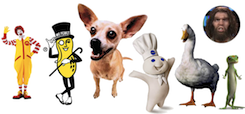 It’s been a gradual switch, but you may have noticed a significant advertising development creeping into advertisements over the past few years. Company mascots are back in favor, and ad firms are using them to market brands in a whole new way. Bucking the recent trend that favored a more sophisticated approach, mascots are providing a personal touch to corporate images that was sorely lacking. Here are ten reasons why mascots are making a comeback:
It’s been a gradual switch, but you may have noticed a significant advertising development creeping into advertisements over the past few years. Company mascots are back in favor, and ad firms are using them to market brands in a whole new way. Bucking the recent trend that favored a more sophisticated approach, mascots are providing a personal touch to corporate images that was sorely lacking. Here are ten reasons why mascots are making a comeback:
- Social media like Facebook are based around personal interaction. Mascots provide users with a “person” with whom to communicate, as opposed to a corporate PR rep. It puts the “face” in Facebook, basically.
- The mascot is a softer sell than the more traditional marketing ploys. Who feels threatened or put off, for instance, when that cute little gecko tells us how much money we can save by switching to Geico? Approximately no one that’s who. How could you when he’s so small and cute?
- When creating a company profile on social networking sites, mascots provide the entity whose profile is being posted, the person who will be providing the updates, etc. Having a consistent mascot spanning each social media profile gives a certain uniformity and familiarity.
- In an economic down period, big companies are looked upon less favorably, and benefit from the good will that a friendly mascot can earn them. Putting a warm, fuzzy face on a cold, impersonal corporate entity eases the trust issue.
- Another by-product of an uncertain economy is a public desire for the safe and familiar. Nostalgia becomes big business, and baby boomers that grew up with company mascots on TV are more welcoming of this advertising approach.
- The huge success of company mascots like Aflac’s duck (313,500 Facebook fans, and 14,537 followers on Twitter) has convinced corporate execs that there is enormous potential in unleashing the mascot beast.
- The Hollywood trend toward CGI and more animated motion pictures has created a culture in which the public is accustomed to responding to non-human characters in a positive way. Consequently, adults who previously might have considered them juvenile are now more receptive to the mascot concept.
- Advertising campaigns are more entertaining when they are centered around regular mascots, like Flo from Progressive Insurance, or those funny little Frosted Mini-Wheats guys. The ads have more lasting impact on viewers than a traditional pitch.
- Company mascots incite reaction from the public. Ad campaigns that tap into the public psyche or invite opinion or response generate more passion and, therefore, a greater brand loyalty, when voiced through an object of affection like a mascot.
- Ongoing storylines that are made possible by giving mascots their own profiles on social media, as well as personalized updates, encourage visitors to return to the website frequently. This enhances interaction between the company and the consumer.
Mascots have made their way into almost every niche, from insurance to cereals, and have created ad campaigns that have resonated with consumers in a positive way. With all the progressive strides that adding a mascot have made for companies, it’s likely that they’ll be around for the long haul.
Taken From Longhorn Leads
No comments:
Post a Comment